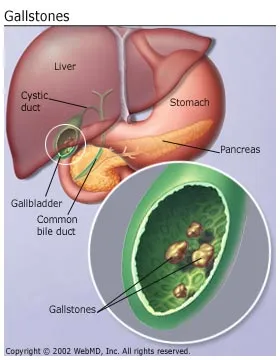ARTICLE Gallstones: What You Need to Know ( courtecy;- webMD ) For starters, they're not really stones. Learn the causes, treatments, and what makes them more likely.
Gallstones: What You Should Know
What Are Gallstones?
They aren’t really stones. They're pieces of solid material that form in the gallbladder, a small organ located under the liver.
You might not even know you have them until they block a bile duct, causing pain that you need to get treated right away.
Types
The two main kinds are:
- Cholesterol stones. These are usually yellow-green in color. They're the most common kind, accounting for 80% of gallstones.
- Pigment stones. These stones are smaller and darker. They're made up of bilirubin, which comes from bile, a fluid your liver makes and your gallbladder stores.

What Causes Gallstones?
There may be several reasons, including:
- Your genes
- Your weight
- Problems with your gallbladder
- Diet
Bile can be part of the problem. Your body needs bile, but if it has too much cholesterol in it, that makes gallstones more likely.
It can also happen if your gallbladder can’t empty properly.
Am I at Risk?
You're more likely to get gallstones if:
You're obese. This is one of the biggest risk factors. Obesity can raise your cholesterol level and also make it harder for the gallbladder to empty completely.
You take birth control pills, hormone replacement therapy for menopause symptoms, or are pregnant. The extra estrogen is the problem. It can increase cholesterol and make it harder for the gallbladder to empty.
You have diabetes. People with this condition tend to have higher levels of triglycerides (a type of blood fat), which is a risk factor for gallstones.
You take medicine to lower your cholesterol. Some of these drugs boost the amount of cholesterol in bile, which may increase your chances of getting cholesterol stones.
You lost weight too quickly. Your liver makes extra cholesterol, which may lead to gallstones.
You’re fasting. Your gallbladder may not squeeze as much.
Gallstones are also more likely if they run in your family, and they're likelier among women, older people, and some ethnic groups, including Native Americans and Mexican-Americans.
What Are the Symptoms?
You might not notice anything, or even know you have gallstones, unless your doctor tells you. But if you do get symptoms, they usually include:
- Pain in your upper belly and upper back that can last for several hours
- Nausea
- Vomiting
- Other digestive problems, including bloating, indigestion and heartburn, and gas
How Do Doctors Diagnose Them?
If your doctor thinks you may have gallstones, he'll give you a physical exam. You may also get:
Blood tests to check for signs of infection or obstruction, and to rule out other conditions.
Ultrasound. This quick procedure makes images of the inside of your body.
CT scan. Specialized X-rays allow your doctor to see inside your body, including your gallbladder.
Magnetic resonance cholangiopancreatography (MRCP). This test uses a magnetic field and pulses of radio-wave energy to make pictures of the inside of your body, including the liver and the gallbladder.
Cholescintigraphy (HIDA scan). This test can check on whether the gallbladder squeezes correctly. Doctors inject a harmless radioactive material, which makes its way to the organ. The technician can then watch its movement.
Endoscopic ultrasound. This test combines ultrasound and endoscopy to look for gallstones.
Endoscopic retrograde cholangiopancreatography (ERCP). The doctor inserts an endoscope through your mouth down to the small intestine and injects a dye to allow the bile ducts to be seen. He can often then remove any gallstones that have moved into the ducts.
What’s the Treatment?
Many people with gallstones get surgery to take out the gallbladder. There are two different kinds of operations.
Laparoscopic cholecystectomy. This is the more common procedure. The surgeon passes instruments, a light, and a camera through several small cuts in the belly. He views the inside of the body on a video monitor. You usually go home the same day.
Open cholecystectomy. The surgeon makes bigger cuts in the belly to remove the gallbladder. You stay in the hospital for a few days after the operation.
If gallstones are in your bile ducts, the doctor may use ERCP to find and remove them before or during gallbladder surgery.
Can You Treat Gallstones Without Surgery?
If you have a medical condition and your doctor feels you shouldn't have an operation, he may prescribe the medications chenodiol (Chenodol), ursodiol (Actigall, Urso 250, Urso Forte), or both. These drugs work by dissolving cholesterol stones. Mild diarrhea can be a side effect.
The downside of using either medication is that you may have to take it for years to completely dissolve the stones, which may come back after you stop taking the drug.
মন্তব্যসমূহ
একটি মন্তব্য পোস্ট করুন